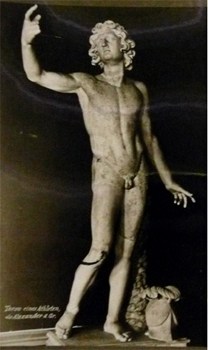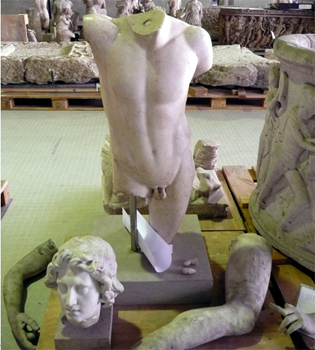Digital Sculpture Project: Alexander
Statue of a young athlete; known as “Alexander”

"Alexander," ca. 1894 |

"Alexander," 2008 |
This statue of the so-called "Alexander" combines ancient and baroque elements. The ancient marble torso was a copy of the statue type known as the "Westmacott Ephebe." It was erroneously restored in the 17th century as Alexander the Great; in the 18th century, it was purchased by August der Starke and brought to Dresden. In the late 19th century, the statue was disassembled. The Dresden State Museums invited The Digital Sculpture project to scan the fragments and create a digital restoration of the piece as it appeared prior to its disassembly. Here we will present a variety of material on our digital reconstructions of the “Alexander”:
Catalog Entry: Statue of a young athlete; “Alexander”
Name: Statue of a young athlete, known as “Alexander”Collection: Staatliche Kunstsammlungen Dresden
Inventory Number: H4 118/254
Date Created: The torso dates to the first half of the IIc CE based on a model of the late Vc BCE with marble supplements of the 17c CE.
Date Acquired: 1728; purchased from the Chigi Collection (Rome).
Sculptor: unknown
Material: Marble
Dimensions: Height 162 cm; width 95 cm; depth 41 cm.
Description: In this statue of a young man lurks the torso of a well-known statue type, the "Westmacott Ephebe." The copy that gave the name to the type was once owned by Richard Westmacott and is now in the British Museum (London). The original represented a young athlete who had raised his right hand to take a crown from his head. The donation of the crown to the victory-bringing gods was a common custom and expression of god-fearing modesty.
The animated position of the youth's body explains the 17c restoration of the Dresden copy as Alexander the Great. In creating it, the unknown baroque sculptor took as his models the bust of the so-called "Dying Alexander" in the Uffizi (Florence) and Lysippus' "Alexander with a Lance," which does not survive but is known from a passage in Plutarch. The supplement of an expressive head and striding limbs transformed the classical torso of an athlete into an emotion-laden representation of the young world conqueror. The high opinion in which the statue was held in the 18c had faded by the end of the 19c, when the baroque additions were removed. A recently finished reconstruction clarifies how the statue was transformed over the centuries.
Selected Bibliography:
- Knoll, Kordelia. Das Albertinum vor 100 Jahren. Die Skulpturensammlung Georg Treus, Ausstellungskatalog Dresden Skulpturensammlung, (Dresden, 1994) 134–136 Nr. 123–125.
[Catalogue entry by Kordelia Knoll]
Each of the 15 fragments of the statue was individually digitized (3D scanned and photographed). The fragments are listed on the table below:
 |
Click the image to view the 3D model (2,000,000 polygons). For help, click here.
|
Copyright © 2009-10. Last updated: June 1, 2010.
The Digital Sculpture Project is an activity of the Virtual World Heritage Laboratory.








